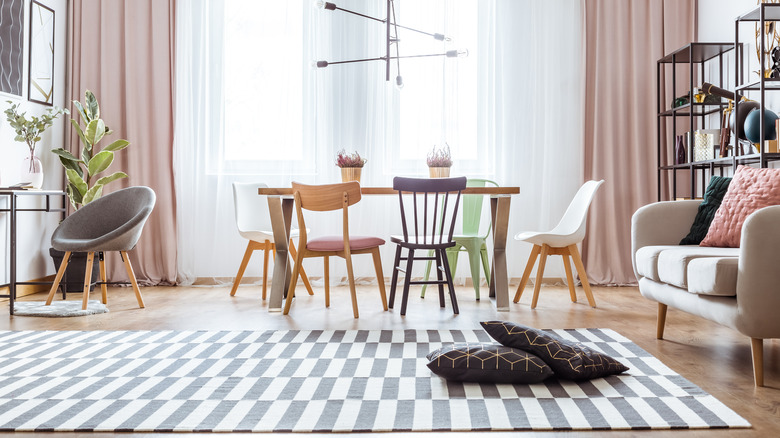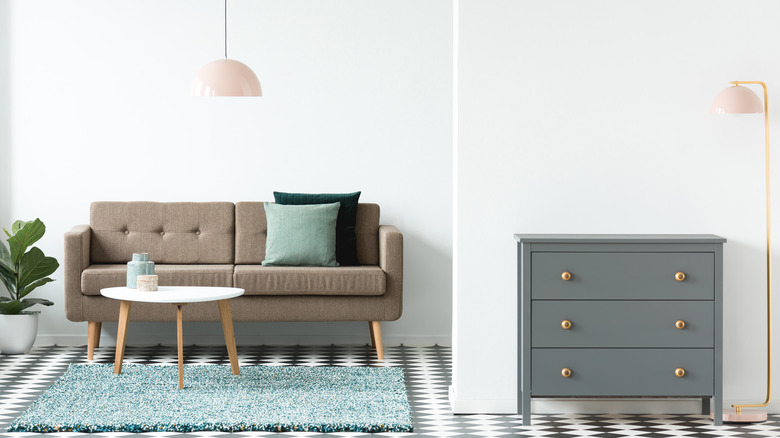The Designer-Approved Alternative To Dated Plaid Patterns In The Home
As an overarching pattern genre, plaid never really goes out of style. Its vertical and horizontal lines, richness of color, and ability to blend with other patterns well are timeless in appeal. Certain varieties of plaid, however, are often affiliated with design trends. While the 1970s often favored more brown-based ruddy plaids on upholstery, the 21st century has popularized the ubiquitous buffalo check in black and neutrals that crops up frequently in more farmhouse-oriented aesthetics.
In addition, certain plaids — such as green-blue or red-blue tartans — often have a look that instantly signifies a more traditional and preppy aesthetic (think Ralph Lauren.) Gingham plaid, on the other hand, can read too casual and country or cottage chic. This means that adding plaid as a design element can be tricky. How to make use of this popular pattern without it looking too dated or over-specific in its influences? Designer Phoenix Orion Grey recently discussed on Instagram how to get the benefits of a plaid without dating your interiors or becoming beholden to a certain style. Instead of other varieties of plaid, Grey suggests using a checkerboard pattern instead.
Usually seen in classic black and white, but occasionally in a range of other surprising or subdued shades, the checkerboard is an ever-popular variation that rivals the lines and visual impact of plaid but in a pared-down, simple way. It's perfect for creating more enduring and dated spaces whatever your aesthetic.
The appeal of checkerboard
The checkerboard pattern has been a popular design element since the ancient era when it appeared in artwork, woven fabrics, and the floors of Egyptian and Roman architecture. It became a popular pattern in the centuries since, through the Medieval era and with the French love of what they called "eschec" pattern for floors and interiors. Made even more widespread by the very identifiable game board, it's remained an enduring pattern found in the design and fashion world, including a recent love of checkerboard rugs for modern spaces.
This timelessness makes it feel both ancient and contemporary, which may be why it suits a number of both modern and vintage-inspired designs so well. In a more contemporary room, it may speak to the geometry and clean lines desired. In an older home, a classic checked floor has a chic European feel. In a diner or vintage-inspired kitchen, it feels like classic 1950s Americana.
Using checkerboard in your space
A classic black-and-white check looks great in both traditional and vintage-inspired rooms, while a checkerboard pattern in earthier colors like brown and terracotta suits boho-style interiors. For grand millennial style, try a bold checkerboard in red or chartreuse. Checkerboard is also a great combo with other patterns like florals, paisley, and damasks, to give a classic look with a lot of visual impact. A classic black-and-white checkerboard tiled floor in a kitchen or foyer can be adapted to many home aesthetics, including industrial, french provincial, or modern farmhouse.
If you're looking for a way to introduce checkerboard as a pattern but aren't sure where to begin, Phoenix Orion Grey suggests — as with all patterns — to try it initially in places like accessories and small touches, rugs, pillows, and lampshades that can always be swapped out if you change your aesthetic later, versus things like wallcoverings and upholstery that are more difficult to switch up. "It can be a great alternative to still give you that fix of plaid visually while adding a little twist," Grey said.

